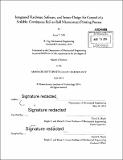| dc.contributor.advisor | David E. Hardt. | en_US |
| dc.contributor.author | Nill, Scott T. (Scott Thomas) | en_US |
| dc.contributor.other | Massachusetts Institute of Technology. Department of Mechanical Engineering. | en_US |
| dc.date.accessioned | 2014-12-08T18:52:38Z | |
| dc.date.available | 2014-12-08T18:52:38Z | |
| dc.date.copyright | 2014 | en_US |
| dc.date.issued | 2014 | en_US |
| dc.identifier.uri | http://hdl.handle.net/1721.1/92152 | |
| dc.description | Thesis: S.M., Massachusetts Institute of Technology, Department of Mechanical Engineering, 2014. | en_US |
| dc.description | Cataloged from PDF version of thesis. | en_US |
| dc.description | Includes bibliographical references (pages 146-150). | en_US |
| dc.description.abstract | Soft lithography has been a long-time candidate for altering the landscape in micromanufacturing. Such processes promise lower cost in equipment and processed products while showing substantial gains in throughput and maximum dimensions. These distinct advantages allow for new advances in production ranging from inexpensive, fully flexible electronics to higher efficiency batteries and improved water purification systems. Microcontact printing ([mu]CP), a particular form of soft lithography, scales the rubber stamp concept down to the micron range. Past work has demonstrated sub-nanometer resolutions attainable with [mu]CP. Currently, microcontact printing is usually performed with a flat stamp and substrate thus limiting the process to batch processing. Recent advancements have enabled conversion of the plate process to a roll-to-plate configuration through in-depth understanding and control of the stamp contact. The transition to full roll-to-roll manufacturing, on increasingly larger scales, presents new challenges for sensing and control of this contact. In the past, the roll-to-roll printing process the control loop has not been closed around the actual contact and transfer process. This thesis presents a new method for sensing, in real-time, this contact process that can be used in roll-to-roll, high-throughput production. Second, the design and implementation of an integrated control and automation system, integrating the novel sensing, is presented. Finally, an overview of the design and production of a precision machine incorporating the sensing, control and automation is given. | en_US |
| dc.description.statementofresponsibility | by Scott T. Nill. | en_US |
| dc.format.extent | 150 pages | en_US |
| dc.language.iso | eng | en_US |
| dc.publisher | Massachusetts Institute of Technology | en_US |
| dc.rights | M.I.T. theses are protected by copyright. They may be viewed from this source for any purpose, but reproduction or distribution in any format is prohibited without written permission. See provided URL for inquiries about permission. | en_US |
| dc.rights.uri | http://dspace.mit.edu/handle/1721.1/7582 | en_US |
| dc.subject | Mechanical Engineering. | en_US |
| dc.title | Integrated hardware, software, and sensor design for control of a scalable, continuous roll-to-roll microcontact printing process | en_US |
| dc.type | Thesis | en_US |
| dc.description.degree | S.M. | en_US |
| dc.contributor.department | Massachusetts Institute of Technology. Department of Mechanical Engineering | |
| dc.identifier.oclc | 897115593 | en_US |
